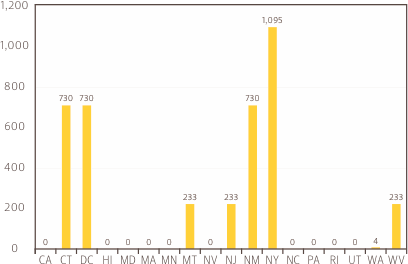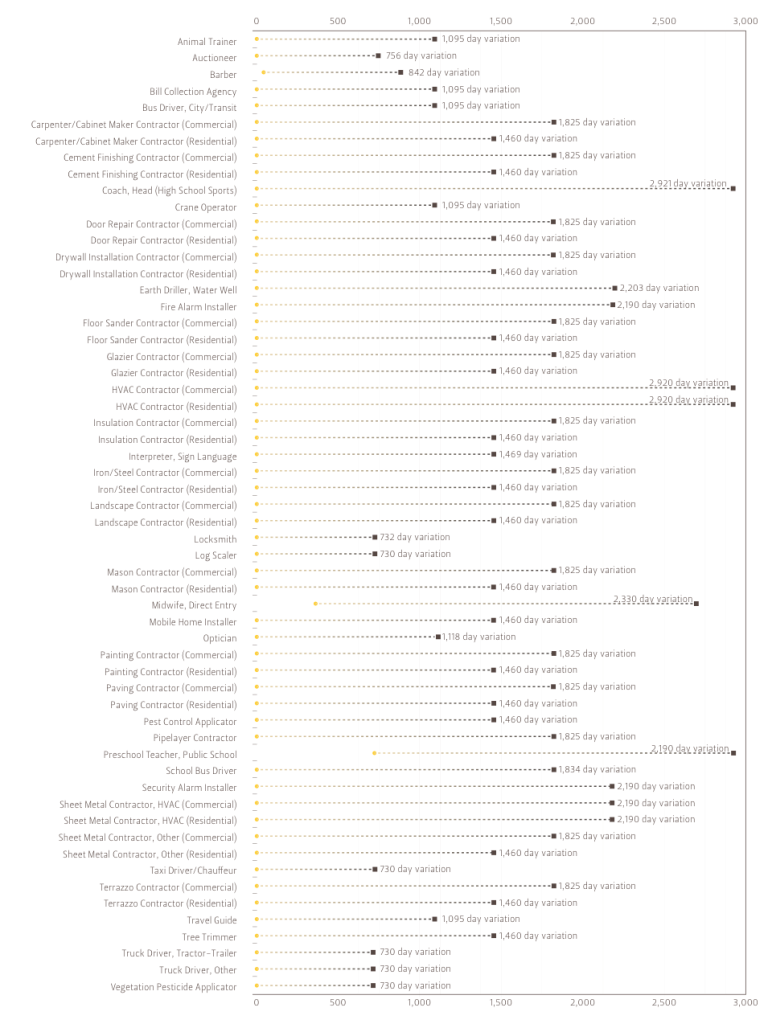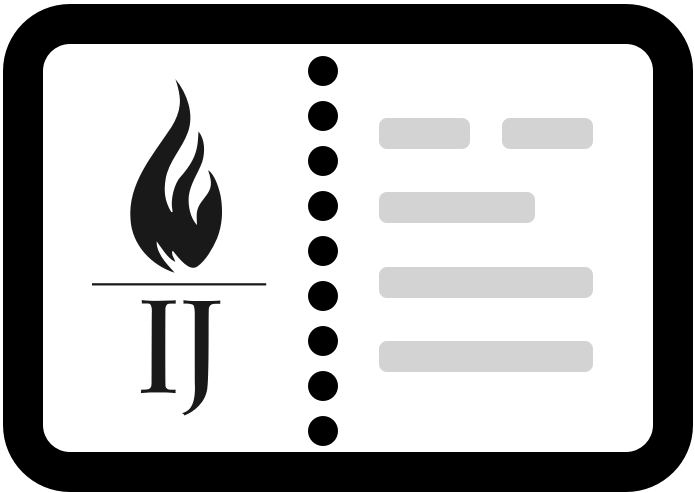The Irrationalities of Occupational Licensure
The data in this report show that licensing of lower-income occupations is not only widespread and onerous but also, in many cases, irrational and arbitrary. In recent years, courts have started coming to this same conclusion. On June 26, 2015, in an Institute for Justice (IJ) case, Patel v. Texas Department of Licensing and Regulation, the Texas Supreme Court struck down a requirement that eyebrow threaders—who practice the ancient South Asian and Middle Eastern art of using a single length of cotton thread to remove unwanted hair—obtain esthetician licenses, an endeavor requiring a high school degree, passage of two examinations and almost a year of irrelevant education and training. (See “Back in Business” to learn more.)
In a sweeping rebuke to the growth and irrationalities of licensing, the court recognized that the state had no basis for imposing such a burden on threaders, writing that, “as applied to them, the requirement of 750 hours of training to become licensed is not just unreasonable or harsh, but it is so oppressive that it violates … the Texas Constitution.”1
But it was not just the burden of requiring an esthetician license for threaders that drew reproach. So, too, did the types of irrationalities this report illustrates. As Justice Don Willett wrote in his concurring opinion joined by two other justices:
As today’s case shows, the Texas occupational licensure regime, predominantly impeding Texans of modest means, can seem a hodge-podge of disjointed, logic-defying irrationalities, where the burdens imposed seem almost farcical, forcing many lower-income Texans to face a choice: submit to illogical bureaucracy or operate an illegal business? Licensure absurdities become apparent when you compare the wildly disparate education/experience burdens visited on various professions. The disconnect between the strictness of some licensing rules and their alleged public-welfare rationale is patently bizarre.2
Unnecessary Licenses
This report’s findings suggest that numerous occupations in various states are licensed unnecessarily. A short list would include auctioneer, florist, funeral attendant, home entertainment installer, interior designer, locksmith, tree trimmer and upholsterer. Most of these occupations are licensed by only a handful of states: funeral attendants by three, tree trimmers by seven and locksmiths by 14. If, as licensure proponents often claim, a license were really necessary to protect public health and safety, one would expect to see greater consistency in which occupations are licensed across states. For example, only seven states license tree trimmers, but it is highly unlikely that trees in those states—or the tasks required to trim them—are any more complex or dangerous than those in the other 44 that require no license.
On average, the 102 occupations studied here are licensed by just 27 states. Only 23 occupations are licensed by 40 states or more. Such inconsistency is suspect. The vast majority of these occupations are practiced in at least one state—and typically many more than one—without need of permission from the state and evidently without widespread harm.
A similar inconsistency is present when examining the number of occupations licensed by state. California, Louisiana, Nevada and Washington license 75 or more of the 102 occupations in this report, while Colorado, Minnesota, Montana, South Dakota, Vermont and Wyoming license fewer than 35. The average state licenses 54, leaving their citizens free to pursue, to no apparent ill effect, many other occupations that are licensed elsewhere.
Inconsistent and Irrational Burdens
In addition to calling into doubt whether some of the occupations studied here need be licensed at all, this report’s findings point to widespread inconsistencies and irrationalities in requirements imposed to enter occupations. A first category of irrationalities is evident when looking at licensing burdens through the lens of the actual risks an occupation poses to the public, both on their face and in comparison to other occupations. A second category flows from inconsistencies in the requirements imposed by different states for the same occupations. And a third category becomes apparent in examining occupations that are licensed rarely but onerously.
First, licensing burdens are often seemingly out of proportion to the public health and safety risks posed by an occupation. Massage therapists, for instance, must spend an average of more than four months in education and training and pass one exam to legally practice in the 44 states that license the occupation. Yet massage therapy is an exceptionally safe occupation. A Vermont state agency reviewed research on the field and concluded that it “tends strongly to suggest massage therapy is very safe.”3 One study cited by the agency identified only 11 cases of harm related to massage therapy between 1965 and 2003, and the agency found no evidence suggesting any safety difference between those with and those without formal training of the sort required for state licensing.4 With such little risk, it makes little sense to require aspiring massage therapists to spend so much time in training to earn government permission to work.
Another example is log scalers, who “[g]rade logs or estimate the marketable content or value of logs or pulpwood in sorting yards, millpond[s], log deck[s] or similar locations,” as well as “[i]nspect logs for defects or measure logs to determine volume.”5 Log scalers are licensed by only two states, but the requirements—two years of experience and passage of a state exam in Maine and passage of two state exams in Idaho—seem peculiarly stringent given that the occupation bears little relationship to public safety.
And as irrational as some licensure burdens look in light of the nature of the work, they frequently look even more so in light of the burdens placed on other occupations with more obvious, and serious, implications for public health and safety. For example, according to the Dictionary of Occupational Titles, an EMT, among other things,
Removes or assists in removal of victims from scene of accident or catastrophe. … Administers prescribed first-aid treatment at site of emergency, or in specially equipped vehicle, performing such activities as application of splints, administration of oxygen or intravenous injections, treatment of minor wounds or abrasions, or administration of artificial resuscitation.6
EMTs hold lives in their hands, yet 73 other occupations have greater average licensure burdens. This includes barbers and cosmetologists, home entertainment installers, interior designers, log scalers, manicurists and numerous contractor designations. For perspective, while the average cosmetologist must complete 386 days of training, the average EMT must complete a mere 34. Even the average tree trimmer must complete more than 16 times the amount of education and experience as the average EMT. Such discrepancies do not mean that EMTs should face steeper requirements. Instead, they suggest barriers for other occupations could be safely lowered.
A second type of irrationality is apparent from glaring inconsistencies in licensing burdens for the same occupations across the states. For example, 14 states have locksmith licenses, with most requiring little or no training. However, New Jersey mandates more than two years of education and experience and passage of a state exam. Eighteen states license crane operators, but 10 of them require no education or experience. Of the other eight states, four require two or more years of experience. Most of the 34 states that license unarmed security guards require a few days of education and experience at most; North Dakota requires 244 days. While 12 states require four months or more of schooling for manicurists, Massachusetts demands less than a month and Virginia a little more than a month. It seems improbable that aspiring manicurists in Alabama, which requires 175 days, or in the 10 states that require 140 days, truly need so much more time in training than their less onerously licensed counterparts in other states. Figure 2 shows the estimated calendar days lost for these four occupations across the states that license them.
Such a high degree of variation is prevalent throughout the occupations studied in this report. As shown in Figure 3, 50 of the 102 have differences of more than 1,000 days between the minimum and maximum number of days of required education and experience. And another eight occupations have differences of more than 700 days.
Finally, the third type of irrationality is visible with those occupations that are licensed by one or only a few states and then very onerously. Just as in the first edition of this report, interior design exemplifies this type of discrepancy. It remains the most difficult occupation to enter while being licensed by only three states and D.C. Similarly, the single state in which psychiatric aides must earn a license requires them to demonstrate two years of experience in order to do so. The two states that license dietetic technicians require 835 days of education and experience, making for the 15th most burdensome requirements. Similar inconsistencies are present among home entertainment installers, social and human service assistants, and tree trimmers. It is already problematic when a state licenses an occupation that no or only a few other states license; it is even more problematic when a state licenses such an occupation very onerously.
Figure 2: Licensing Burdens Vary Widely
Estimated Calendar Days Lost for Four Occupations Across Licensed States
Locksmith, Licensed in 14 states

Crane Operator, Licensed in 18 States

Unarmed Security Guard, Licensed in 34 states

Manicurist, Licensed in 50 states

Figure 3: Wide Variation in Licensing Burdens Is Common
For 58 Occupations, Estimated Calendar Days Lost Varies by 700 Days or More



